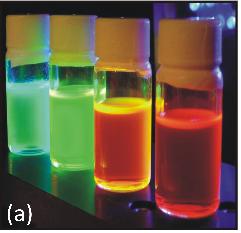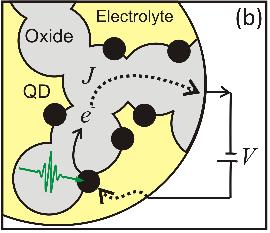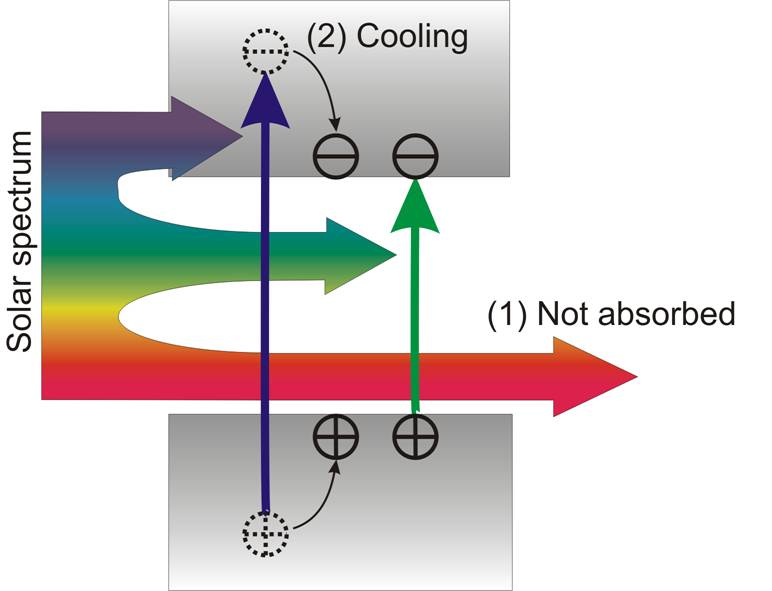In the Nanostructured
Photovoltaics group we aim developing solar cell architectures
that exploit the potential of nanotechnology. Our ambition is to
unravel and tailor the optoelectronic properties of nanometer
sized semiconductors for obtaining low cost-high
efficiency solar cell devices. Our approach is
multidisciplinary, combining fundamental research on sample's physico-chemistry with solar cell device engineering.
Quantum dot
solar cells
|
Semiconductor quantum dot (QD) nanocrystals can be exploited as
light absorbing entities in nanostructured solar cells. The
ability to systematically change the QD absorption threshold
with nano-crystal size (fig. a) allows fine tuning
of its optoelectronic properties.
Quantum dot
sensitized solar cells (QD-SSCs) represents one of the potential routes
for developing thin film-low cost photovoltaic devices (2nd
generation photovoltaics). In these
solar cells, sunlight is absorbed by a semiconductor nanocrystal
sensitizer
(QD donor) which is anchored to the surface of a nanostructured
mesoporous oxide (oxide acceptor, see fig. b). |
|
 |
|
|
|
|
|
 |
|
The photocurrent (J) in QD-SSCs
is primarily determined by the efficient transfer of photogenerated electrons
from the QD to the oxide. The nanostructured nature of the
oxide, which is defined by a high surface to volume ratio,
allows high photocurrents in solar cell
devices. The output voltage (V) of the solar cell will be
ultimately
determined by the
absorption threshold
of the employed QD sensitizer, which can be tuned to match
the energetics of electron and hole acceptor contacts
(oxide's conduction band and electrolyte's redox potential)
for maximum solar cell efficiency. |
Apart from exciton
generation-dissociation, other kinetic processes such as carrier
transport and recombination will determine the performance of
devices. In nanostructured systems, where attaching contacts to the sample
is tricky, it is convenient to interrogate those processes by
optical means. A unique tool to do
so is THz time domain spectroscopy (THz-TDS), where freely
propagating THz pulses are employed as a probe for determining the
complex conductivity of the samples.
Furthermore, the high time resolution of THz pulses
(with durations of ~1 picosecond) allows the study of dynamic
processes out of equilibrium using a optical pump-THz probe
scheme.
Other relevant
topics that influence solar cell performance in approaches like the
QD-SSCs are long term stability issues (e.g. sensitizers prone
to photo-oxidation), surface defect engineering (e.g. the
passivation of surface physico-chemical impurities acting as
recombination centers), assembling of nanocrystals (e.g. homogenous
sensitization of oxides) and device engineering (e.g. encapsulation
issues and sample to sample reliability).
Third generation photovotaic
concepts
Conventional solar cell
approaches suffer from two intrinsic major energy loss channels (fig. c):
(1) their inability to absorb photons with energy less than the
device absorption threshold and (2) the waste of photon energy when
photons with energies above the device absorption threshold are
absorbed (cooling). These aspects set an upper efficiency limit for
solar cell photoconversion of aprox 30% (the Shockley-Queisser
limit). Recently, thanks in part to the emergence of high
quality nano-structures, extensive attention has been paid to
developing the so called "third generation photovoltaic concepts”
that aim efficiencies exceeding the Shockley-Queisser limit.
|
The routes to
surpass 30% efficiencies can be grouped into three generic
categories, namely: (i) multiple energy threshold devices
(e.g. multi-junction and multi-transition solar
cells); (ii) the use of excess thermal energy to enhance
voltages or carrier collection (e.g. hot carrier solar cells
and carrier multiplication); and (iii) the modification of
the incident spectrum (e.g. up-down conversion). Part of our
research effort is focused on identifying nanostructured
systems that can be exploited in any of those approaches. |
|
 |